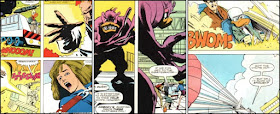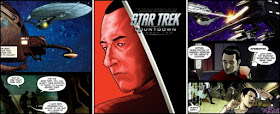 |
| DOCTOR STRANGE No. 12, December 2016 |
Indeed, the Inkpot Award-winner’s script provides plenty of ‘tongue-in-cheek’ proof that the former “preeminent surgeon” has trouble accessing any sort of enchantment whatsoever, by temporarily overcoming the supernatural being Mister Misery by chewing some mystic gum from Auckland and momentarily besting his arch-rival with the toss of a magic apple; “This is even worse than I expected…. This is just pathetic. I feel almost like I’m doing you a favour.” The “Star Wars” writer even includes a scene set within The Bar With No Doors, where Stephen discusses potentially getting himself a car entitled the Strange-Mobile with Chondu in order to help him get about town quicker...
Equally as enthralling though, is the marked difference the invasion and subsequent defeat of the Empirikul has had on Karl Amadeus Mordo. The Ancient One’s one-time apprentice is clearly just as formidable a Master of Black Magic as he has ever been, despite almost all the magic on Earth being destroyed by the Imperator’s inter-dimensional army, and yet seems more in the thrall of his master, the dread Dormammu than he’s arguably been depicted before. In fact, having watched the Lord of the Dark Dimension literally reduce a female tenant into cube-sized chunks of bloody flesh, the resentful, ordinarily arrogant Baron is so petrified that he races from the mutilation in abject horror.
Unfortunately, despite its sound penmanship, Issue Twelve of “Doctor Strange” does disconcertingly suffer as a result of Chris Bachalo’s ordinarily marvellous illustrations being inked by no less than five different people. Just why editor Nick Lowe ended up supplementing regular Tim Townsend with Richard Friend, Al Vey, Victor Olazaba and John Livesay isn’t clear, but their combined efforts definitely lead to a deterioration in the comic’s overall artistic quality, especially during an apparently poorly-pencilled scene where Mordo ‘evicts’ a family from their skyline private residence.
 |
| Writer: Jason Aaron, Artist: Chris Bachalo, and Colors: Antonio Fabela |


































